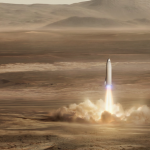Sinuous Gullies Snake Down Sand Dune on Mars (Photo)0
- From Around the Web, Space
- November 1, 2017
These Martian gullies may be linear, but they’re far from straight.

These Martian gullies may be linear, but they’re far from straight.

Color-discerning capabilities that NASA’s Curiosity rover has been using on Mars since 2012 are proving particularly helpful on a mountainside ridge the rover is now climbing.

Mars has an invisible magnetic ‘tail’ that is twisted by interaction with the solar wind, according to new research using data from NASA’s MAVEN spacecraft.

The planet Mars shares its orbit with a handful of small asteroids, the so-called Trojans. Among them, one finds a unique group, all moving in very similar orbits, suggesting that they originated from the same object.

A solar event on September 11, 2017 sparked a global aurora on the Red Planet more than 25 times brighter than any previously seen by NASA’s MAVEN (Mars Atmosphere and Volatile Evolution) spacecraft. The event also produced radiation levels on the Martian surface more than double any previously measured by NASA’s Curiosity rover.

The discovery of evidence for ancient sea-floor hydrothermal deposits on Mars identifies an area on the planet that may offer clues about the origin of life on Earth.

More than 150 years after it happened, scientists are still taking about the Carrington Event—a solar storm in Sept. 1859 that sparked Northern Lights as far south as Cuba and sprayed the entire surface of Earth with high energy radiation.

How something as small as meteorites can change how we view something as big as Mars.

Governments and private firms are collaborating on projects to send humans to new frontiers, with NASA planning missions to the space between the earth and moon to prepare for trips to Mars.

Musk says project codenamed BFR would also allow commercial travel to anywhere on Earth in under an hour